动静分离、Rewirte、HTTPS
Nginx动静分离技术
这里的代理服务器其实就是静态资源处理服务器,图示为了区分动静分离所以分开,静态服务器中;
存放的资源主要是源代码文件、图片、属性、样式以及其它所有非动态的资源文件;
动静分离也是为了提高网站的性能,如果静态请求直接使用代理服务器处理,动态请求再流量分配到客户动态资源处理服务器;
下面以上文的BBS项目演示,将BBS图片分离演示静态请求~
示例搭建步骤
部署NFS#
通过部署NFS实现静态文件共享
1、创建NFS挂载点
[root@nfs ~]# mkdir /static
2、配置挂载点
[root@nfs static]# vim /etc/exports
/static 172.16.1.0/20(rw,sync,all_squash,anonuid=666,anongid=666)
3、启动服务
[root@nfs static]# systemctl restart nfs rpcbind
4、检查是否正常
[root@nfs static]# showmount -e
Export list for nfs:
/static 172.16.1.0/20
5、授权
[root@nfs /]# chown -R www.www /static/
静态资源共享#
实现图片文件共享挂载
1、所有客户端创建挂载点
[root@web01 /]# mkdir -p /opt/static/s
2、所有客户端挂载
[root@web01 opt]# mount -t nfs 172.16.1.31:/static /opt/static/
3、查看
[root@web01 opt]# df -h
172.16.1.31:/static 20G 3.1G 17G 16% /opt/static
4、静态资源共享
[root@web01 static]# cp -r /opt/bbs/static/* /opt/static/s/
[root@web01 static]# ll /opt/static/s/
total 0
drwxr-xr-x 5 www www 40 Jan 7 15:36 bootstrap
drwxr-xr-x 2 www www 23 Jan 7 15:36 css
drwxr-xr-x 2 www www 168 Jan 7 15:36 font
drwxr-xr-x 4 www www 30 Jan 7 15:36 img
部署代理服务器#
1、安装nfs工具包
[root@lb01 ~]# yum install nfs-utils -y
2、创建挂载点
[root@lb01 ~]# mkdir /opt/static/
3、挂载
[root@lb01 ~]# mount -t nfs 172.16.1.31:/static /opt/static/
[root@lb01 ~]# df -h
172.16.1.31:/static 20G 3.1G 17G 16% /opt/static
4、修改配置文件
# 增加location匹配规则,匹配静态资源
upstream bbs {
server 172.16.1.7:80 max_fails=3 fail_timeout=3s;
server 172.16.1.8:80 max_fails=3 fail_timeout=3s;
server 172.16.1.9:80 max_fails=3 fail_timeout=3s;
}
server {
listen 80;
server_name py.test.com;
location / {
proxy_pass http://bbs;
proxy_next_upstream error timeout invalid_header http_500 http_502 http_503 http_404;
include /etc/nginx/proxy_params;
}
location ~ \.(jpg|png|gif|js|css|woff|ttf|woff2)$ {
root /opt/static;
}
}
测试
Rewrite(重点)
Rewrite主要实现url地址重写,以及重定向,就是把传入web的请求重定向到其他url的过程。案例:京东就重定向了URL
Rewrite基本概述#
- 地址跳转,用户访问www.linux.com这个URL是,将其定向至一个新的域名www.baidu.com。
- 协议跳转,用户通过http协议请求网站时,将其重新跳转至https协议方式。
- 伪静态,将动态页面显示为静态页面方式的一种技术,便于搜索引擎的录入,同时建上动态URL地址对外暴露过多的参数,提升更高的安全性。
- 搜索引擎,SEO优化依赖于url路径,好记的url便于搜索引擎录入。(应用:百度热词,广告等)
rewrite语法#
# 语法和范围
Syntax: rewrite regex replacement [flag];
Default: —
Context: server, location, if
# 名称解释
rewrite # 模块命令
regex # 请求的链接(支持正则表达式)
replacement # 跳转的链接
[flag]; # 标签
# 格式示例
location /download/ {
rewrite ^(/download/.*)/media/(.*)\..*$ $1/mp3/$2.mp3 break;
rewrite ^(/download/.*)/audio/(.*)\..*$ $1/mp3/$2.ra break;
return 403;
}
rewrite标记Flag#
rewrite指令根据表达式来重定向URL,或者修改字符串,可以应用于server,location,if环境下,每行rewrite指令最后跟一个flag标记,支持的flag标记有如下表格所示:
| flag | 作用 |
|---|---|
| last | 本条规则匹配完成后,停止匹配,不再匹配后面的规则 |
| break | 本条规则匹配完成后,停止匹配,不再匹配后面的规则 |
| redirect | 返回302临时重定向,地址栏会显示跳转后的地址 |
| permanent | 返回301永久重定向,地址栏会显示跳转后的地址 |
last和break的区别#
- break请求:
- 请求linux.rewrite.com/break
- 匹配 location ~ ^/break 会跳转到 linux.rewrite.com/test
- 请求跳转后,回去查找本地站点目录下的 /test
- 如果找到了,则返回/code/test/index.html的内容;
- 如果没找到该目录则报错404,如果找到该目录没找到对应的文件则403
- last请求:
- 请求linux.rewrite.com/last
- 匹配 location ~ ^/last 会跳转到 linux.rewrite.com/test
- 如果找到了,则返回/code/test/index.html的内容;
- 如果没有找到,会重新对当前server发起请求,这个时候访问地址就变成 linux.rewrite.com/test
- 重新请求server会匹配到 location /test/ 直接返回该location的内容
- 如果也没有location匹配,再返回404;
示例如下:
[root@lb01 conf.d]# vim /etc/nginx/conf.d/flag.conf
server {
server_name rewrite.test.com;
listen 80;
location ~ ^/break {
rewrite (.*) /test break;
}
location ~ ^/last {
rewrite (.*) /test last; #
}
location /test {
default_type text/html;
return 200 "test";
}
}
last:访问的过程是匹配last没有匹配成功,重新发起请求匹配到test打印返回值test
break:访问过程是去网站根目录找test,没有找到就不会重新发起请求,所以404
redirect和permanent的区别#
- redirect: 每次请求都会询问服务器,如果当服务器不可用时,则会跳转失败。
- permanent: 第一次请求会询问,浏览器会记录跳转的地址,第二次则不再询问服务器,直接通过浏览器缓存的地址跳转。
重定向格式
location /redirect {
rewrite (.*) http://www.baidu.com redirect;
}
location /permanent {
rewrite (.*) http://www.baidu.com permanent;
}
# 示例
server {
server_name rewrite.test.com;
listen 80;
location ~ ^/break {
rewrite (.*) /test break;
}
location ~ ^/last {
rewrite (.*) /test last;
}
location /test {
default_type text/html;
return 200 "test";
}
location /redirect {
rewrite (.*) http://www.baidu.com redirect;
}
location /permanent {
rewrite (.*) http://www.baidu.com permanent;
}
}
redirect和permanent是重定向,跳转域名,而last和break不会改名访问的域名
HTTPS
为什么需要使用HTTPS,因为HTTP不安全,当我们使用http网站时,会遭到劫持和篡改,如果采用https协议,那么数据在传输过程中是加密的,所以黑客无法窃取或者篡改数据报文信息,同时也避免网站传输时信息泄露。
那么我们在实现https时,需要了解ssl协议,但我们现在使用的更多的是TLS加密协议。
那么TLS是怎么保证明文消息被加密的呢?在OSI七层模型中,应用层是http协议,那么在应用层协议之下,我们的表示层,是ssl协议所发挥作用的一层,他通过(握手、交换秘钥、告警、加密)等方式,是应用层http协议没有感知的情况下做到了数据的安全加密
模拟网站劫持
正常的页面#
[root@web01 opt]# mkdir code
[root@web01 opt]# vim /code/index.html
<!DOCTYPE html PUBLIC "-//W3C//DTD XHTML 1.0 Transitional//EN" "http://www.w3.org/TR/xhtml1/DTD/xhtml1-transitional.dtd">
<html xmlns="http://www.w3.org/1999/xhtml">
<head>
<meta http-equiv="Content-Type" content="text/html; charset=utf-8" />
<title>学生信息注册页面</title>
</head>
<body>
<h3 align="center">学生信息注册</h3>
<form name="stu"action="">
<table>
<tr><td>姓名:</td><td><input type="text"name="stuName"/></td></tr>
<tr><td>性别:</td>
<td><input type="radio"name="stuSex"checked="checked">男
<input type="radio"name="stuSex">女
</td>
</tr>
<tr><td>出生日期</td>
<td><input type="text"name="stuBirthday"></td>
<td>按格式yyyy-mm-dd</td>
</tr>
<tr><td>学校:</td><td><input type="text"name="stuSchool"></td></tr>
<tr><td>专业:</td>
<td><select name="stuSelect2">
<option selected>计算机科学与技术</option>
<option>网络工程</option>
<option>物联网工程</option>
<option>应用数学</option>
</select>
</td>
</tr>
<tr><td>体育特长:</td>
<td colspan="2">
<input type="checkbox"name="stuCheck" >篮球
<input type="checkbox"name="stuCheck" >足球
<input type="checkbox"name="stuCheck" >排球
<input type="checkbox"name="stuCheck" >游泳
</td>
</tr>
<tr><td>上传照片:</td><td colspan="2"><input type="file" ></td></tr>
<tr><td>密码:</td><td><input type="password"name="stuPwd" ></td></tr>
<tr><td>个人介绍:</td>
<td colspan="2"><textarea name="Letter"rows="4"cols="40"></textarea></td>
</tr>
<tr>
<td><input type="submit"value="提交" ><input type="reset"value="取消" ></td>
</tr>
</table>
</form>
</body>
</html>
# 配置文件
[root@web01 conf.d]# vim https.conf
server{
listen 80;
server_name https.test.com;
location / {
root /opt/code;
index index.html;
}
}
# 域名解析 hosts
正常页面
网站劫持#
1、安装缺少的模块
# 删除原来的nginx
[root@lb01 ~]# rm -rf nginx-1.20.2
[root@lb01 ~]# tar -xf nginx-1.20.2.tar.gz
[root@lb01 nginx-1.20.2]# ./configure --help | grep sub
--with-http_sub_module enable ngx_http_sub_module
[root@lb01 nginx-1.20.2]# ./configure --with-http_gzip_static_module --with-stream --with-http_ssl_module --with-http_sub_module
[root@lb01 nginx-1.20.2]# make && make install
# 将原来的nginx删除,移动新更新的nginx
[root@lb01 sbin]# cd /usr/local/nginx/sbin/
[root@lb01 sbin]# ll
total 13888
-rwxr-xr-x 1 root root 7110376 Jan 7 21:29 nginx
[root@lb01 sbin]# rm -rf /usr/sbin/nginx
[root@lb01 sbin]# mv nginx /usr/sbin/nginx
# 配置文件
[root@lb01 ~]# vim /etc/nginx/conf.d/https.conf
server {
listen 80;
server_name https.test.com;
location / {
proxy_pass http://192.168.15.7;
sub_filter '<title>学生信息注册页面</title>' '<title>澳门首家线上赌场</title>';
sub_filter '<h3 align="center">学生信息注册</h3>' '<h3 align="center">VIP用户信息注册</h3>';
sub_filter '<tr><td>性别:</td>' '<tr><td>爱好:</td>';
sub_filter '<option selected>计算机科学与技术</option>' '<option selected>按摩</option>';
sub_filter '<option>网络工程</option>' '<option>抽烟</option>';
sub_filter '<option>物联网工程</option>' '<option>喝酒</option>';
sub_filter '<option>应用数学</option>' '<option>烫头</option>';
sub_filter '<tr><td>上传照片:</td><td colspan="2"><input type="file" ></td></tr>' '<img src="https://blog.driverzeng.com/zenglaoshi/xingganheguan.gif">';
}
}
[root@lb01 ~]# nginx -t
nginx: the configuration file /usr/local/nginx/conf/nginx.conf syntax is ok
nginx: configuration file /usr/local/nginx/conf/nginx.conf test is successful
[root@lb01 ~]# systemctl restart nginx
这样在负载均衡中就劫持了
加密流程
1、浏览器发起往服务器的443端口发起请求,请求携带了浏览器支持的加密算法和哈希算法。
2、服务器收到请求,选择浏览器支持的加密算法和哈希算法。
3、服务器下将数字证书返回给浏览器,这里的数字证书可以是向某个可靠机构申请的,也可以是自制的。
4、浏览器进入数字证书认证环节,这一部分是浏览器内置的TLS完成的:
4.1 首先浏览器会从内置的证书列表中索引,找到服务器下发证书对应的机构,如果没有找到,此时就会提示用户该证书是不是由权威机构颁发,是不可信任的。如果查到了对应的机构,则取出该机构颁发的公钥。
4.2 用机构的证书公钥解密得到证书的内容和证书签名,内容包括网站的网址、网站的公钥、证书的有效期等。浏览器会先验证证书签名的合法性(验证过程类似上面Bob和Susan的通信)。签名通过后,浏览器验证证书记录的网址是否和当前网址是一致的,不一致会提示用户。如果网址一致会检查证书有效期,证书过期了也会提示用户。这些都通过认证时,浏览器就可以安全使用证书中的网站公钥了。
4.3 浏览器生成一个随机数R,并使用网站公钥对R进行加密。
5、浏览器将加密的R传送给服务器。
6、服务器用自己的私钥解密得到R。
7、服务器以R为密钥使用了对称加密算法加密网页内容并传输给浏览器。
8、浏览器以R为密钥使用之前约定好的解密算法获取网页内容。
证书对比
自签证书#
# 使用openssl命令充当CA权威机构创建证书(生产不使用此方式生成证书,不被互联网认可的黑户证书)
[root@web01 conf.d]# cd /etc/nginx/
[root@web01 nginx]# mkdir ssl
[root@web01 ssl]# openssl genrsa -idea -out server.key 2048
Generating RSA private key, 2048 bit long modulus
................................................................................+++
...........................................+++
e is 65537 (0x10001)
Enter pass phrase for server.key:123456
Verifying - Enter pass phrase for server.key:123456
[root@web01 ssl]# ll
total 4
-rw-r--r-- 1 root root 1739 Jan 7 21:48 server.key
# 生成自签证书(公钥),同时去掉私钥的密码
[root@web01 ssl]# openssl req -days 36500 -x509 -sha256 -nodes -newkey rsa:2048 -keyout server.key -out server.crt
Generating a 2048 bit RSA private key
........................................................................................................+++
...........................+++
writing new private key to 'server.key'
-----
You are about to be asked to enter information that will be incorporated
into your certificate request.
What you are about to enter is what is called a Distinguished Name or a DN.
There are quite a few fields but you can leave some blank
For some fields there will be a default value,
If you enter '.', the field will be left blank.
-----
Country Name (2 letter code) [XX]:
State or Province Name (full name) []:
Locality Name (eg, city) [Default City]:
Organization Name (eg, company) [Default Company Ltd]:
Organizational Unit Name (eg, section) []:
Common Name (eg, your name or your server's hostname) []:
# req --> 用于创建新的证书
# new --> 表示创建的是新证书
# x509 --> 表示定义证书的格式为标准格式
# key --> 表示调用的私钥文件信息
# out --> 表示输出证书文件信息
# days --> 表示证书的有效期
# sha256 --> 加密方式
# 浏览器加载证书的配置
#1.开启证书
Syntax: ssl on | off;
Default: ssl off;
Context: http, server
#2.指定证书文件
Syntax: ssl_certificate file;
Default: —
Context: http, server
#3.指定私钥文件
Syntax: ssl_certificate_key file;
Default: —
Context: http, server
# web01单个服务器增加证书
server{
# listen 80;
listen 443 ssl;
# server_name https.test.com;
ssl_certificate /etc/nginx/ssl/server.crt;
ssl_certificate_key /etc/nginx/ssl/server.key;
location / {
root /opt/code;
index index.html;
}
}
# 负载均衡增加证书步骤,这样所有的服务器都有了
# 同步证书文件
[root@web01 nginx]# scp -r /etc/nginx/ssl 192.168.15.5:/etc/nginx/
root@192.168.15.5's password:
server.key 100% 1704 1.9MB/s 00:00
server.crt 100% 1220 921.7KB/s 00:00
[root@lb01 conf.d]# vim https.conf
upstream ssl {
server 172.16.1.7;
server 172.16.1.8;
server 172.16.1.9;
}
server {
listen 443 ssl;
server_name _;
ssl_certificate /etc/nginx/ssl/server.crt;
ssl_certificate_key /etc/nginx/ssl/server.key;
location / {
proxy_pass http://ssl;
include /etc/nginx/proxy_params;
}
}
# 80端口的重定向
server {
listen 80;
server_name _;
rewrite (.*) https://192.168.15.5 permanent;
}
# 修改完成web01就不用自签证书了
测试自签证书
【菜鸟进步中,如有错请指正,感谢~】

 Nginx反向代理实现动静分离技术,Rewrite重定向URL,负载均衡使用HTTPS自签证书,这篇文章都有👆
Nginx反向代理实现动静分离技术,Rewrite重定向URL,负载均衡使用HTTPS自签证书,这篇文章都有👆

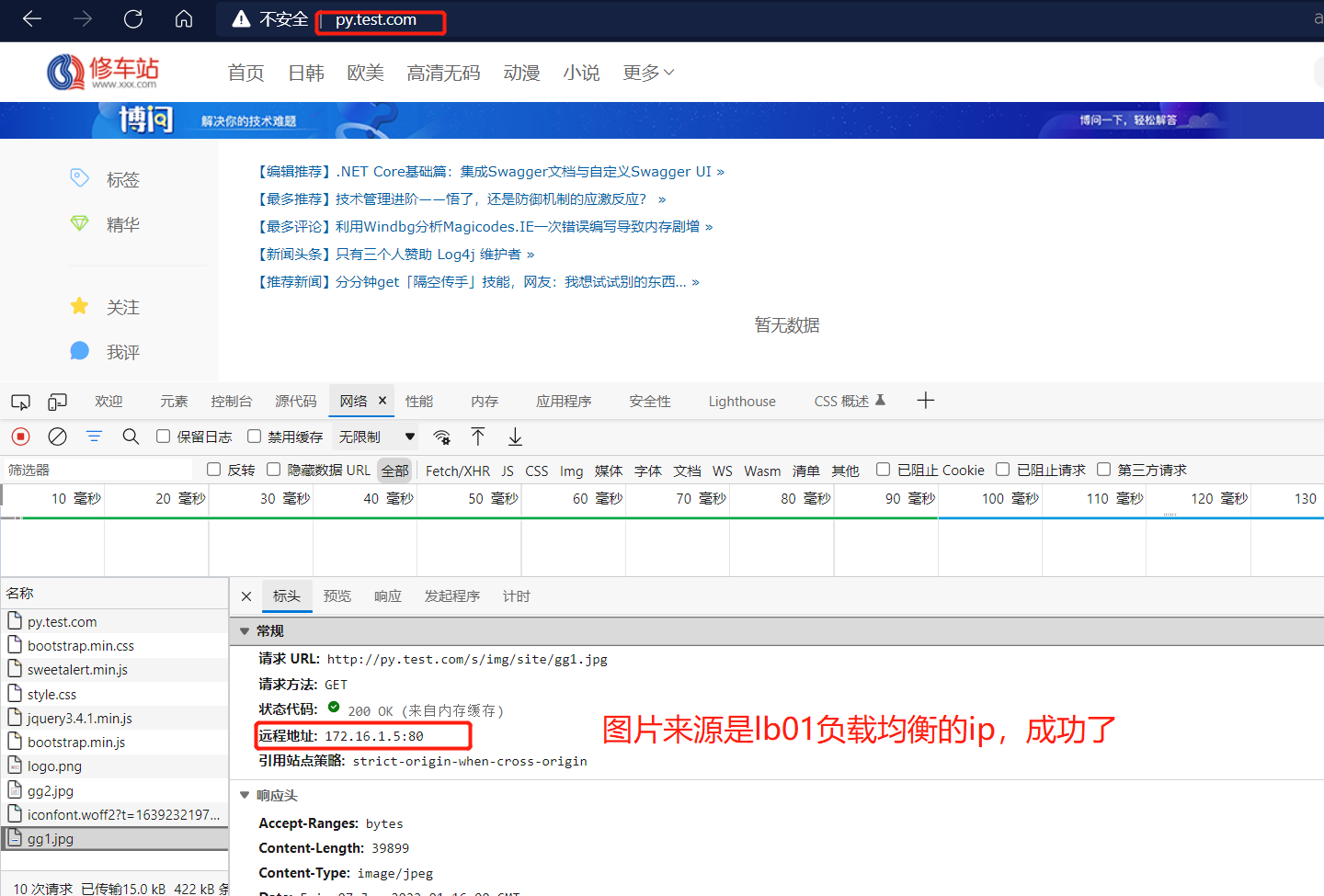
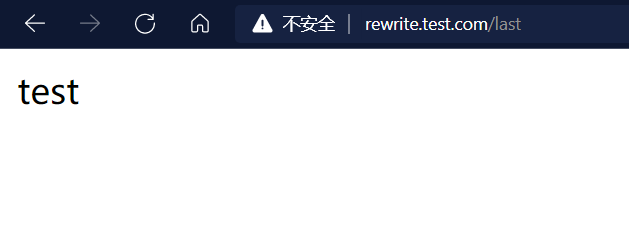


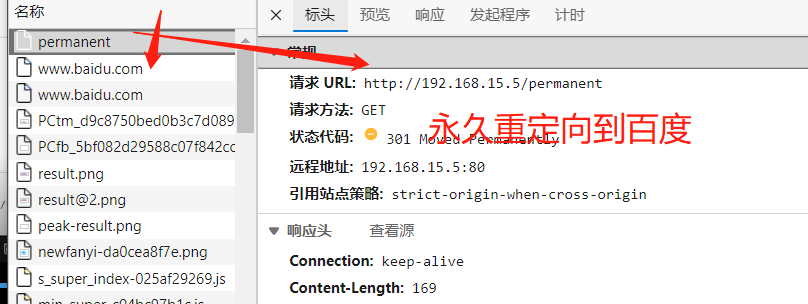

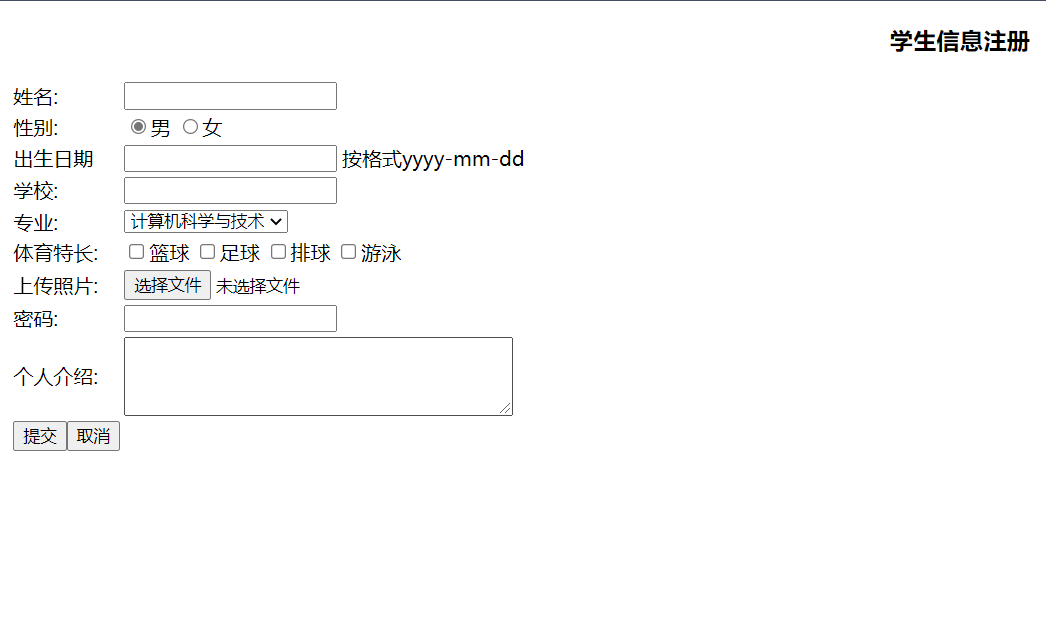





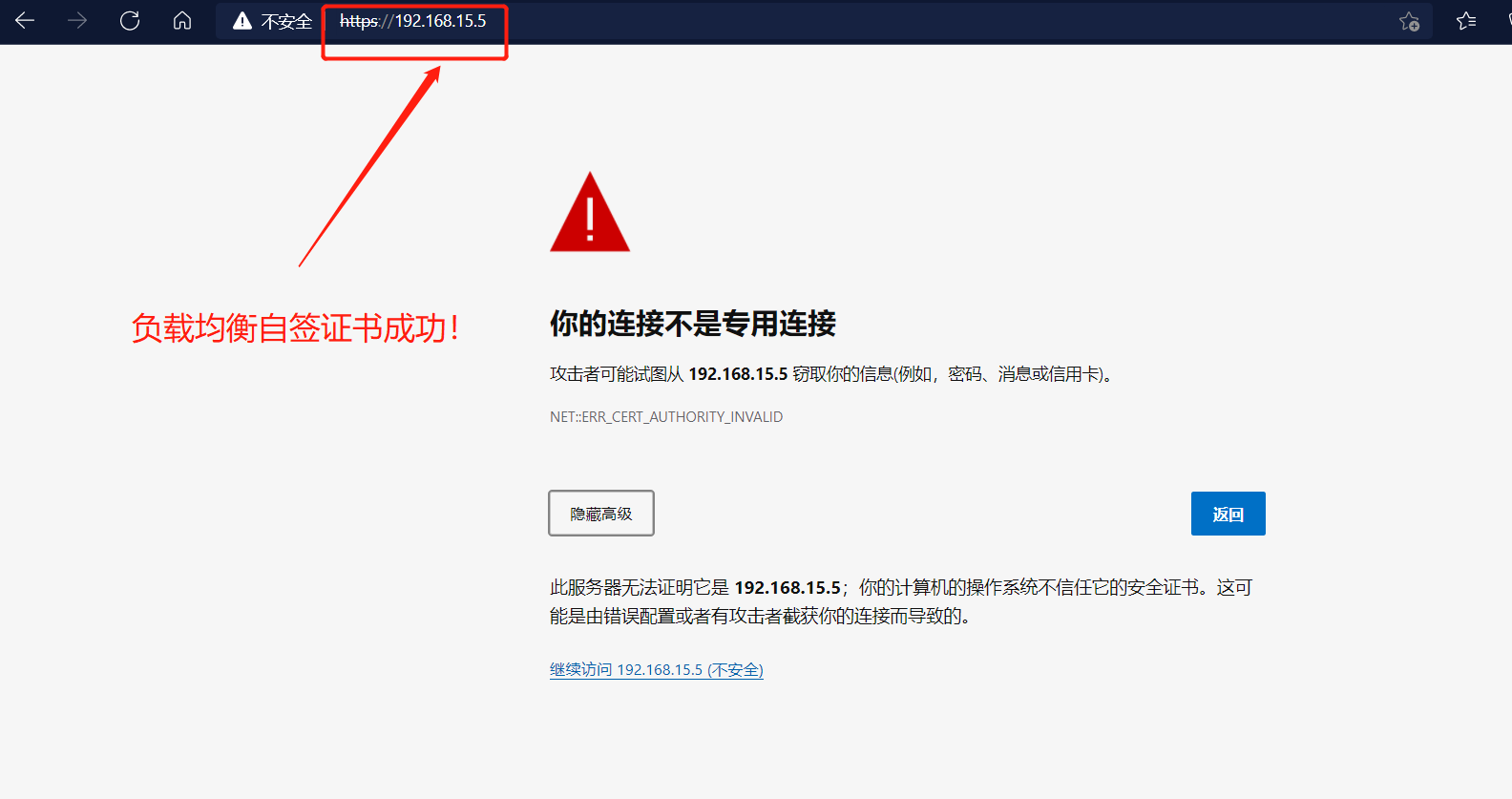



【推荐】国内首个AI IDE,深度理解中文开发场景,立即下载体验Trae
【推荐】编程新体验,更懂你的AI,立即体验豆包MarsCode编程助手
【推荐】抖音旗下AI助手豆包,你的智能百科全书,全免费不限次数
【推荐】轻量又高性能的 SSH 工具 IShell:AI 加持,快人一步
· 被坑几百块钱后,我竟然真的恢复了删除的微信聊天记录!
· 没有Manus邀请码?试试免邀请码的MGX或者开源的OpenManus吧
· 【自荐】一款简洁、开源的在线白板工具 Drawnix
· 园子的第一款AI主题卫衣上架——"HELLO! HOW CAN I ASSIST YOU TODAY
· Docker 太简单,K8s 太复杂?w7panel 让容器管理更轻松!